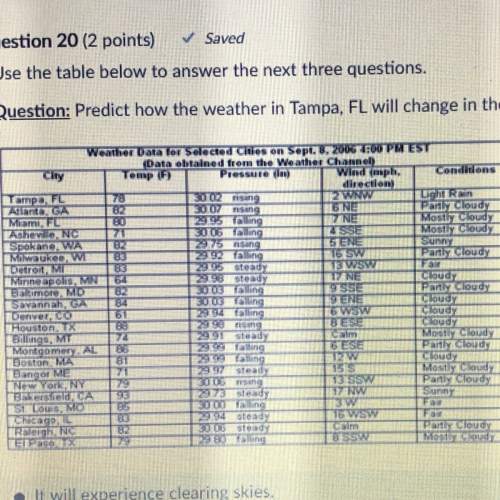
Physics, 08.01.2021 14:00 annamariaafowyhrq
Identify at least one example each of absorption, transmission, reflection, and refraction of waves in this photograph.


Answers: 1


Another question on Physics

Physics, 22.06.2019 11:00
I'm thinking it's 2 you are asked to explain the earth's magnetic field. which is the best reply? 1. the earth's magnetic south is similar to the north pole of a magnet. 2. the earth's core has a strong magnetic charge similar to the south pole of a magnet. 3. the earth's geomagnetic south is similar to the south pole of a magnet. 4. the earth's magnetic charge is not centered at either pole; it varies based on location.
Answers: 1

Physics, 22.06.2019 19:30
Amass m = 74 kg slides on a frictionless track that has a drop, followed by a loop-the-loop with radius r = 18.4 m and finally a flat straight section at the same height as the center of the loop (18.4 m off the ground). since the mass would not make it around the loop if released from the height of the top of the loop (do you know why? ) it must be released above the top of the loop-the-loop height. (assume the mass never leaves the smooth track at any point on its path.) 1. what is the minimum speed the block must have at the top of the loop to make it around the loop-the-loop without leaving the track? 2. what height above the ground must the mass begin to make it around the loop-the-loop? 3. if the mass has just enough speed to make it around the loop without leaving the track, what will its speed be at the bottom of the loop? 4. if the mass has just enough speed to make it around the loop without leaving the track, what is its speed at the final flat level (18.4 m off the ground)? 5. now a spring with spring constant k = 15600 n/m is used on the final flat surface to stop the mass. how far does the spring compress?
Answers: 3

Physics, 22.06.2019 20:20
An electron is trapped at a defect in a crystal. the defect may be modeled as a one-dimensional, rigid-walled box of width 1.00 nm. (a) sketch the wavefunctions and probability densities for the n 1 and n 2 states. (b) for the n 1 state, nd the probability of nding the electron between x1 0.15 nm and x2 0.35 nm, where x 0 is the left side of the box. (c) repeat (b) for the n 2 state. (d) calculate the energies in electron volts of the n 1 and n 2 states
Answers: 1

Physics, 22.06.2019 23:40
Consider a u-tube whose arms are open to the atmosphere. now equal volumes of water and light oil (ρ = 49.3 lbm/ft3) are poured from different arms. a person blows from the oil side of the u-tube until the contact surface of the two fluids moves to the bottom of the u-tube, and therefore, the liquid levels in the two arms are the same. if the fluid height in each arm is 30 in, determine the gage pressure exerted by the person on the oil by blowing.
Answers: 3
You know the right answer?
Identify at least one example each of absorption, transmission, reflection, and refraction of waves...
Questions




Mathematics, 07.04.2021 18:20








History, 07.04.2021 18:20








Mathematics, 07.04.2021 18:20




